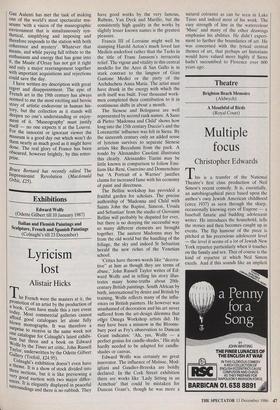Exhibitions
Edward Wolfe
(Odette Gilbert till 10 January 1987)
Italian and Flemish Paintings and Sculpture, French and Spanish Paintings (Colnaghi's till 23 December)
Lyricism lost
Alistair Hicks
he French were the masters at it, the promotion of an artist by the production of a book. Costs have made this a rare event "ay. Most commercial galleries cannot afford good catalogues let alone fully blown monographs. It was therefore a surprise to receive M the same week not one catalogue for Colnaghi's latest exhibi- tion but three and a book on Edward Wolfe by the Times art critic, John Russell ylor, underwritten by the Odette Gilbert Gallery (Trefoil, £24.95). Colnaghi's exhibition doesn't even have a theme. It is a show of stock divided into three sections, but it is like previewing a very good auction with two major differ- ences. It is elegantly displayed in peaceful surroundings and there is no rubbish. They have good works by the very famous, Rubens, Van Dyck and Murillo, but the consistently high quality in the works by slightly lesser known names is the greatest pleasure.
Francis III of Lorraine might well be stamping Harold Acton's much loved last Medicis underfoot rather than the Turks in the title of Frans Janssens's terracotta relief. The vigour and vitality in this central modello for the Arco di San Gallo is in stark contrast to the languor of Gian Gastone Medici or the piety of the Archduchess Anna Maria. The artist must have drunk in the energy with which the arch itself was built. Four thousand work- men completed their contribution to it in continuous shifts in about a month.
The Sienese and Bolognese are well represented by second rank names. A Sano di Pietro 'Madonna and Child' shows how long into the 15th century Duccio's and the Lorenzettis' influence was felt in Siena. By the sixteenth century only an added sense of lyricism survives to separate Sienese artists like Beccafumi from the pack. A tondo by Alessandro Casolani illustrates this clearly. Alessandro Tiarini may be little known in comparison to follow Emi- lians like Reni, Guercino and Domenchino but 'A Portrait of a Warrior' justifies claims for increased fame with his economy of paint and directness.
The Bellini workshop has provided a fruitful garden for scholars. The precise authorship of 'Madonna and Child with Saints John the Baptist, Simeon, Ursula and Sebastian' from the studio of Giovanni Bellini will probably be disputed for ever, but there is no denying the successful way so many different elements are brought together. The austere Madonna may be from the old world but the handling of the foliage, the sky and indeed St Sebastian herald the new riches of the Venetian school.
`Critics have thrown words like "decora- tive" at him as though they are terms of abuse,' John Russell Taylor writes of Ed- ward Wolfe and in telling his story illus- trates many home-truths about 20th- century British paintings. South African by birth, international by desire and British by training, Wolfe reflects many of the influ- ences on British painters. He however was unashamed of decoration and his art never suffered from the art-design dilemma that oar Omega Workshop artists did. He may have been a minnow in the Blooms- bury pool as Fry's observation to Duncan Grant indicates: `Ah, yes, Wolfe — a perfect genius for candle-shades.' His style hardly needed to be adapted for candle- shades or canvas.
Edward Wolfe was certainly no great innovator. The influence of Matisse, Mod- igliani and Gaudier-Brzeska are boldly declared. In the Cork Street exhibition there are works like 'Lady Sitting in an Armchair' that could be mistaken for Duncan Grant's, though he was more a natural colourist as can be seen in Lake Tasso and indeed most of his work. The easy strength of line in the watercolour `Muse' and many of the other drawings emphasise his abilities. He didn't experi- ment to further the boundaries of art. He was concerned with the lyrical central themes of art, that perhaps art historians would have valued more highly if Siena hadn't succumbed to Florence over 600 years ago.


































































 Previous page
Previous page